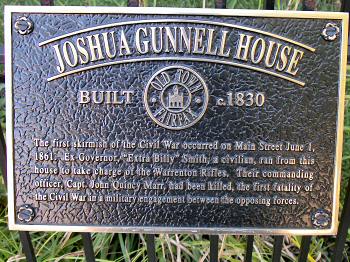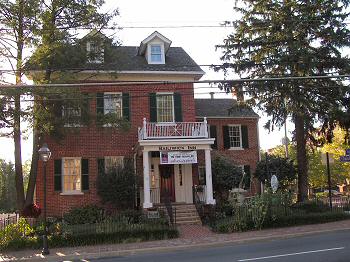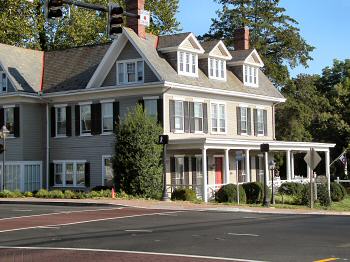|
Fairfax
Joshua Gunnell House, Built c. 1830 |
|
Fairfax
Joshua Gunnell House
The first skirmish of the Civil War occurred on Main Street, June 1,
1861. Ex-Governor, "Extra Billy" Smith, a civilian , ran from this house
to take charge of the Warrenton Rifles. Their commanding officer, Capt.
John Quincy Marr had been killed, the first Confederate officer killed
during the Civil War in a military engagement between the opposing forces.
Union Lt. Col. Robert Johnstone was billeted here during Ranger Mosby's
March 9, 1863 raid. They did not succeed in capturing Col. Johnstone of
the 5th New York Cavalry, but they did embarrass him to the extent that it
followed him for the rest of his career. Awakened by the sounds of cavalry
passing his window, Johnstone challenged them. Realizing they were the
enemy, Johnstone made his escape through the back door, while his wife
held the rebels at bay at the front door. (some witnesses would later jest
that Mrs. Johnstone gave them the only opposition they would encounter on
the whole raid!). Johnston eluded the rebels by hiding under an outhouse
in his undershirt. When that story got around camp, it was enough to make
him wish he'd been captured instead, having acquired the nickname of
"Outhouse Johnstone" |
|
Fairfax
Moore House, Built c. 1840
During his March 9, 1863 raid, Ranger John S. Mosby searched here, with no
success, for the Union mercenary Col. Percy Wyndham who had called Mosby a
horse thief. Mosby had replied that the only horses he had ever stolen had
Union troopers on their backs armed with two pistols and a saber. This was
later R. Walton Moore's home, congressman and counselor of the State
Department under Franklin D. Roosevelt who was entertained here.
(President William Howard Taft attended a garden party here sometime after
his presidency.) |
|
Fairfax
Draper House, Built c. 1820
Built by Dr. Samuel Draper, this house served as his home, office, and
examining room. Its Flemish bond brickwork, box-like appearance and large
end chimneys are typical of Federal style architecture. Many of the
structure's original out-buildings have been converted into shops |



